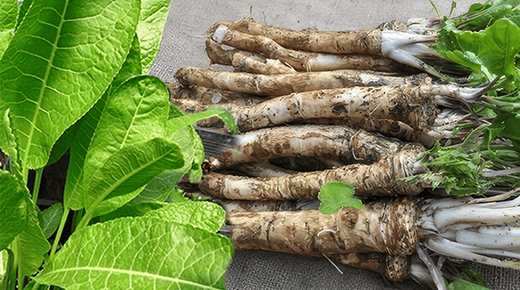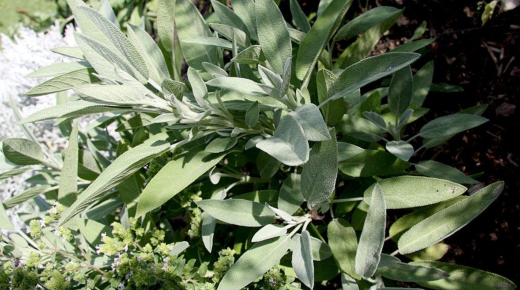2023
MAY - JULY

HORSERADISH
Horseradish is a popular condiment with a strong flavour. Not just tasty but it also has plenty of health benefit. It is originated in South-East Europe and has many health benefits. The word “horseradish” comes from the word “horse,” which formerly meant rough, and “radish” from the Latin word “radix,” meaning root. The root contains several antioxidants that treat respiratory disorders like mucus and sinusitis. They also help combat bacterial infections, including that of the urinary tract.
The Benefits of Horseradish:
1. Helps Combat Cancer
The glucosinolates in horseradish were found to activate the cancer-fighting enzymes, and this can prove beneficial to patients combating cancer. What is more interesting is that these glucosinolates, in the plant world, actually protect the plants from toxic environments. In fact, horseradish contains 10 times more glucosinolates than broccoli. There are other preliminary studies that state how horseradish can induce death of colon cancer cells. All of this only accentuates the possibility of glucosinolates being used as a potential cancer cure.
2. Is An Antioxidant Powerhouse
Horseradish root possesses several phytocompounds, types of antioxidants that are extremely beneficial to human health. Some other antioxidants in horseradish are antimutagenic, which means that they can protect the body from mutagens that otherwise inflict grave harm. (Mutagen means genotoxic, i.e. a toxic substance that affects the genetic material of body and sexual cells and changes the genetic information stored in DNA).
3. Can Help Treat Urinary Tract Infections
The antibiotic properties of horseradish can help treat urinary tract infections in some cases, better than conventional treatment. Another reason horseradish works well in this aspect is sinigrin. Sinigrin is an effective diuretic and prevents water retention, and this helps deal with urinary tract infections.
4. Enhances Digestion
Certain enzymes in the root can stimulate digestion and aid bowel movements. Horseradish root is also considered a cholagogue, i.e., it stimulates bile production in the gallbladder – thereby aiding digestion.
5. Fights Inflammation
Some studies state that horseradish can help fight inflammation – it achieves this by reducing the release of reactive oxygen species. Several parts of Chinese medicine have recommended the use of horseradish to help prevent inflammation – be it in the case of injury or even for relief from arthritis pains.
6. Eases Respiratory Ailments
The antibiotic properties of the root can play a major role in treating respiratory ailments. In fact, traditional medicine has seen the use of horseradish root for treating bronchitis, cough, common cold, and sinusitis.
7. Has Antimicrobial Properties
Studies have shown that some compounds in horseradish can offer protection against a variety of microbes. And in yet another study, the horseradish essential oil seemed the most resistance against bacterial growth.
8. Helps Treat Melasma
Melasma is a condition where brown patches appear on the face. But since horseradish root has bleaching properties, it can help treat skin discoloration – which is the primary symptom of melasma.
You can simply cut the horseradish root into slices and rub one directly on your skin. Ensure the juice of the root is applied to the affected areas. You can allow it to dry and then rinse with lukewarm water and pat dry. Repeat once a week until the brown patches fade.
You can also mix two tablespoons of horseradish powder with one cup of sour cream. Apply the mixture to your face and leave it on for 30 minutes. Wash your face with lukewarm water. Repeat once a week until you see positive results.
9. Horseradish Can Help Reduce Age Spots
The bleaching properties of horseradish helps here. You can make horseradish paste and apply it to the affected areas. Leave it on for about 20 minutes and then wash it off with lukewarm water. You can follow this remedy a few times a week.
Alternately, you can grate a 10 cm piece of horseradish and mix it with a quarter cup of apple cider vinegar. Allow the mixture to sit for about two weeks. Using a cotton ball, apply it to the affected areas. Follow this remedy thrice a day for about a month.
10. Can Boost Hair Growth
Though there is little research on this, some sources say that the antioxidants in horseradish help regenerate hair and prevent hair loss. They achieve this by improving circulation to the scalp.
FEBRUARY - APRIL

SAGE
Sage (Salvia officinalis) is also called common sage, garden sage or just sage. It is a perennial, evergreen subshrub, with woody stems, grayish leaves, and blue to purplish flowers. It belongs to the mint family, alongside other herbs like oregano, rosemary, basil, and thyme. Sage is considered one of the “wonder’ herbs in herbal medicine.
Sage according traditions:
• contains vitamins A and C, along with several other antioxidants and is also rich in vitamin K, which aids the body in clotting blood.
• antibacterial and antiseptic.
• along with thyme, and propolis helps reduce inflammation as well as imparting antibacterial properties.
• is linked to several health benefits, including improved brain function and lower cancer risk.
• is also helpful for gingivitis (inflammation of the gum) and sore throats, as well as gastritis (inflammation of stomach lining).
• can help with excessive sweating that can occur with changes in hormones.
• can be helpful for nervous exhaustion, nervous tension and headaches.
• calms the digestive system and reduces cramping if you suffer from reflux.
• is helpful for improving memory and senses.
• has antimicrobial properties that may kill microbes that encourage the growth of dental plaque.
• helps reduce the intensity and frequency of menopause symptoms, such as hot flashes and irritability.
• slowers blood sugar levels by increasing insulin sensitivity.
Sage tea
1 cup (2½ dl) water
4-5 sage leaves
few drops of lemon juice, to taste
pinch of sugar, to taste
Method
1. Bring the water to boil.
2. Take off the heat and pour on sage leaves.
3. Let it steep for about 5 minutes.
4. Add sugar and lemon juice.
5. Stir well and serve it warm.
Tips
1. Sage pairs well with many other herbs and natural sweeteners.
• Lavender or mint plays up the refreshing aspect.
• Rosemary will accentuate the pine taste.
• Fresh grated ginger will bring a bit of heat and a zing.
• Maple syrup or honey will offer a bright sweetness along with a floral aroma.
2. You can make the tea iced instead – chill it after steeping and infuse some fresh blackberries, or blueberries, or why not raspberries.